Design Guidelines for Database-Driven Internet of Things-Enabled Dynamic Spectrum Access
Abstract
1. Introduction
- A framework for DSA consisting of a supporting IoT network of spectrum sensors that feed a WSDB, which drives the DSA functionalities enabled by the DLT.
- A set of guidelines and technological enablers to support the implementation of all planes of the framework and to demonstrate its feasibility.
2. Background
2.1. White-Space Database
2.2. Spectrum Sensing
2.3. Database-Assisted Spectrum Sensing
3. DSA-Related Solutions
3.1. Integration of Spectrum Sensing and White-Space Databases
3.2. Distributed Ledger Technology
3.3. Literature Gaps and Research Opportunities
4. Database-Driven IoT-Enabled DSA Framework
4.1. Overview
4.2. Enabling Technologies—Network Level
4.3. WSDB Architecture
4.4. Enabling Technologies—WSDB
5. Challenges and Open Issues
5.1. Security and Privacy
5.2. Cloud Computing and Functions Placement
5.3. Distributed Ledger Technology
5.4. The Role of DLT in Architecture
5.5. Distributed Ledger Centralization Versus Decentralization
5.6. Public Versus Private Blockchain
5.7. Distributed Ledger Energy Expenditure and Scalability
5.8. Smart Contracts
5.9. Data, Services and Database/DLT Interoperability
6. Conclusions
Author Contributions
Funding
Conflicts of Interest
References
- Hong, X.; Wang, J.; Wang, C.X.; Shi, J. Cognitive radio in 5G: A perspective on energy-spectral efficiency trade-off. IEEE Commun. Mag. 2014, 52, 46–53. [Google Scholar] [CrossRef]
- Zhang, L.; Xiao, M.; Wu, G.; Alam, M.; Liang, Y.C.; Li, S. A survey of advanced techniques for spectrum sharing in 5G networks. IEEE Wirel. Commun. 2017, 24, 44–51. [Google Scholar] [CrossRef]
- Mitola, J.; Maguire, G.Q. Cognitive radio: Making software radios more personal. Pers. Commun. IEEE 1999, 6, 13–18. [Google Scholar] [CrossRef]
- Goldsmith, A.; Jafar, S.A.; Maric, I.; Srinivasa, S. Breaking Spectrum Gridlock With Cognitive Radios: An Information Theoretic Perspective. Proc. IEEE 2009, 97, 894–914. [Google Scholar] [CrossRef]
- Corral-de-Witt, D.; Ahmed, S.; Awin, F.; Rojo-Álvarez, J.L. An Accurate Probabilistic Model for TVWS Identification. Appl. Sci. 2019, 9, 4232. [Google Scholar] [CrossRef]
- Holland, O.; Bogucka, H.; Medeisis, A. Opportunistic Spectrum Sharing and White Space Access: The Practical Reality, 1st ed.; John Wiley & Sons, Inc.: Hoboken, NJ, USA, 2015; pp. 1–665. [Google Scholar] [CrossRef]
- Harada, H. White space communication systems: An overview of regulation, standardization and trial. IEICE Trans. Commun. 2014, E97-B, 261–274. [Google Scholar] [CrossRef]
- IEEE. IEEE Standard for Information Technology—Local and Metropolitan Area Networks—Specific Requirements—Part 22: Cognitive Wireless RAN Medium Access Control (MAC) and Physical Layer (PHY) Specifications: Policies and Procedures for Operation in the TV Bands; IEEE Std 802.22-2011; IEEE: Piscataway, NJ, USA, 2011; pp. 1–680. [Google Scholar] [CrossRef]
- Federal Communications Commission. Amendment of Part 15 of the Commission’s Rules for Unlicensed Operations in the Television Bands, Repurposed 600 MHz Band, 600 MHz Guard Bands and Duplex Gap, and Channel 37: Notice of Proposed Rulemaking; Notice of Proposed Rulemaking, ET Docket No. 14; FCC: Washington, DC, USA, 2014; Volume 144.
- Ofcom. A Framework for Spectrum Sharing. Available online: https://www.ofcom.org.uk/__data/assets/pdf_file/0032/79385/spectrum-sharing-framework.pdf (accessed on 2 December 2020).
- Akyildiz, I.F.; Lo, B.F.; Balakrishnan, R. Cooperative spectrum sensing in cognitive radio networks: A survey. Phys. Commun. 2011, 4, 40–62. [Google Scholar] [CrossRef]
- Arjoune, Y.; Kaabouch, N. A comprehensive survey on spectrum sensing in cognitive radio networks: Recent advances, new challenges, and future research directions. Sensors 2019, 19, 126. [Google Scholar] [CrossRef]
- Qin, Z.; Gao, Y.; Parini, C.G. Data-Assisted Low Complexity Compressive Spectrum Sensing on Real-Time Signals under Sub-Nyquist Rate. IEEE Trans. Wirel. Commun. 2016, 15, 1174–1185. [Google Scholar] [CrossRef]
- Ariyarathna, T.; Harankahadeniya, P.; Isthikar, S.; Pathirana, N.; Bandara, H.M.N.D.; Madanayake, A. Dynamic Spectrum Access via Smart Contracts on Blockchain. In Proceedings of the 2019 IEEE Wireless Communications and Networking Conference (WCNC), Marrakesh, Morocco, 15–18 April 2019; pp. 1–6. [Google Scholar] [CrossRef]
- Danzi, P.; Kalor, A.E.; Sorensen, R.B.; Hagelskjaer, A.K.; Nguyen, L.D.; Stefanovic, C.; Popovski, P. Communication Aspects of the Integration of Wireless IoT Devices with Distributed Ledger Technology. IEEE Netw. 2020, 34, 47–53. [Google Scholar] [CrossRef]
- Belotti, M.; Božić, N.; Pujolle, G.; Secci, S. A Vademecum on Blockchain Technologies: When, Which, and How. IEEE Commun. Surv. Tutor. 2019, 21, 3796–3838. [Google Scholar] [CrossRef]
- Abbade, L.R.; Ribeiro, F.M.; d. Silva, M.H.; Morais, A.F.P.; d. Morais, E.S.; Lopes, E.M.; Alberti, A.M.; Rodrigues, J.J.P.C. Blockchain Applied to Vehicular Odometers. IEEE Netw. 2020, 34, 62–68. [Google Scholar] [CrossRef]
- Bozic, N.; Pujolle, G.; Secci, S. Securing virtual machine orchestration with blockchains. In Proceedings of the 2017 1st Cyber Security in Networking Conference (CSNet), Rio de Janeiro, Brazil, 18–20 October 2017; pp. 1–8. [Google Scholar]
- Tasic, A.M.; Narathong, C.; Sahota, G.S.; Patel, S. Spectrum Sensing Radio Receiver. Patent WO2015153311A1, 8 October 2015. Available online: https://patents.google.com/patent/WO2015153311A1/en (accessed on 19 April 2021).
- Ramirez, D.; Via, J.; Santamaria, I.; Scharf, L.L. Locally Most Powerful Invariant Tests for Correlation and Sphericity of Gaussian Vectors. IEEE Trans. Inf. Theory 2013, 59, 2128–2141. [Google Scholar] [CrossRef]
- Chaurasiya, R.B.; Shrestha, R. Area-Efficient and Scalable Data-Fusion based Cooperative Spectrum Sensor for Cognitive Radio. IEEE Trans. Circuits Syst. II Express Briefs 2020, 1. [Google Scholar] [CrossRef]
- Guimarães, D.A. Pietra-Ricci Index Detector for Centralized Data Fusion Cooperative Spectrum Sensing. IEEE Trans. Veh. Technol. 2020, 69, 12354–12358. [Google Scholar] [CrossRef]
- IEEE. IEEE Standard for Information Technology—Telecommunications and Information Exchange between Systems—Local and Metropolitan Area Networks—Specific Requirements—Part 11: Wireless LAN Medium Access Control (MAC) and Physical Layer (PHY) Specifications Amendment 5: Television White Spaces (TVWS) Operation; IEEE Std 802.11af-2013 (Amendment to IEEE Std 802.11-2012, as Amended by IEEE Std 802.11ae-2012, IEEE Std 802.11aa-2012, IEEE Std 802.11ad-2012, and IEEE Std 802.11ac-2013); IEEE: Piscataway, NJ, USA, 2014; pp. 1–198. [Google Scholar] [CrossRef]
- Zhu, L.; Chen, V.; Malyar, J.; Das, S.; McCann, P. Protocol to Access White-Space (PAWS) Databases. In Internet Engineering Task Force; RFC: Fremont, CA, USA, 2015; Volume 7545. [Google Scholar]
- Luo, Y.; Gao, L.; Huang, J. Economics of Database-Assisted Spectrum Sharing; Wireless Networks; Springer International Publishing: Cham, Switzerland, 2016; pp. 1–16. [Google Scholar] [CrossRef]
- Federal Communications Commission. Amendment of Part 15 of the Commission’s Rules for Unlicensed Operations in the Television Bands, Repurposed 600 MHz Band, 600 MHz Guard Bands and Duplex Gap, and Channel 37; Report and Order, No. 15; FCC: Washington, DC, USA, 2015; Volume 99.
- Federal Communications Commission. Wireless Telecommunications Bureau and Office of Engineering and Technology Approve Four Spectrum Access System Administrators for Full Scale Commercial Deployment in the 3.5 GHz Band and Emphasize Licensee Compliance Obligations in the 3650–3700 MHz Band under Part 96; Public Notice, GN Docket No. 15; FCC: Washington, DC, USA, 2020; Volume 319.
- Federal Communications Commission. 3.5 GHz Band Overview. Available online: https://www.fcc.gov/wireless/bureau-divisions/mobility-division/35-ghz-band/35-ghz-band-overview (accessed on 2 December 2020).
- LS Telcom. Channel Availability. Available online: https://www.whitespaceforus.com_wsdb_wsdb_ui_Channel_Availability.html (accessed on 2 December 2020).
- Spiridon, S. Toward 5G Software Defined Radio Receiver Front-Ends; SpringerBriefs in Electrical and Computer Engineering; Springer International Publishing: Cham, Switzerland, 2016. [Google Scholar] [CrossRef]
- Shairi, N.A.; Ahmad, B.; Wong, P. SPDT discrete switch design using switchable radial stub resonator for WiMAX and LTE in 3.5 GHz band. In Proceedings of the 2013 IEEE International RF and Microwave Conference (RFM), Penang, Malaysia, 9–11 December 2013; pp. 1–5. [Google Scholar] [CrossRef]
- Shellhammer, S.J. Spectrum sensing in IEEE 802.22. In Proceedings of the IAPR Workshop on Cognitive Information Processing (CIP 2008), Santorini, Greece, 9–10 June 2008. [Google Scholar]
- Ma, Y.; Zhang, X.; Gao, Y. Joint sub-Nyquist spectrum sensing scheme with geolocation database over TV white space. IEEE Trans. Veh. Technol. 2017, 67, 3998–4007. [Google Scholar] [CrossRef]
- Ofcom. The Wireless Telegraphy (White Space Devices) (Exemption) Regulations 2015. Available online: https://www.legislation.gov.uk/uksi/2015/2066/pdfs/uksi_20152066_en.pdf (accessed on 2 December 2020).
- Wang, N.; Gao, Y.; Evans, B. Database-augmented spectrum sensing algorithm for cognitive radio. In Proceedings of the 2015 IEEE International Conference on Communications (ICC), London, UK, 8–12 June 2015; pp. 7468–7473. [Google Scholar] [CrossRef]
- Stevenson, C.R.; Chouinard, G.; Lei, Z.; Hu, W.; Shellhammer, S.J.; Caldwell, W. IEEE 802.22: The first cognitive radio wireless regional area network standard. IEEE Commun. Mag. 2009, 47, 130–138. [Google Scholar] [CrossRef]
- Paisana, F.; Miranda, J.P.; Marchetti, N.; Dasilva, L.A. Database-aided sensing for radar bands. In Proceedings of the 2014 IEEE International Symposium on Dynamic Spectrum Access Networks, DYSPAN 2014, McLean, VA, USA, 1–4 April 2014; pp. 1–6. [Google Scholar] [CrossRef]
- Tang, M.; Zheng, Z.; Ding, G.; Xue, Z. Efficient TV white space database construction via spectrum sensing and spatial inference. In Proceedings of the 2015 IEEE 34th International Performance Computing and Communications Conference (IPCCC), Nanjing, China, 14–16 December 2015; pp. 1–5. [Google Scholar]
- Aslam, S.; ul Haq, A.; Jang, J.W.; Lee, K.G. Unified channel management for cognitive radio sensor networks aided internet of things. Sensors 2018, 18, 2665. [Google Scholar] [CrossRef]
- Vartiainen, J.; Matinmikko-Blue, M.; Karvonen, H.; Mendes, L. Spectrum Sharing and Operator Model for Rural and Remote Area Networks. In Proceedings of the 2019 16th International Symposium on Wireless Communication Systems (ISWCS), Oulu, Finland, 27–30 August 2019; pp. 53–57. [Google Scholar]
- Dionísio, R.; Ribeiro, J.; Marques, P.; Rodriguez, J. Combination of a geolocation database access with infrastructure sensing in TV bands. Eurasip J. Wirel. Commun. Netw. 2014, 2014, 1–14. [Google Scholar] [CrossRef][Green Version]
- Cognitive Radio Experimentation World. Project Overview|CREW Project. Available online: http://www.crew-project.eu/index.html (accessed on 2 December 2020).
- Tran, H.N.; Sun, C.; Alemseged, Y.D.; Harada, H. A distributed sensing and caching database for cognitive radio systems. IEICE Trans. Commun. 2012, 95, 217–225. [Google Scholar] [CrossRef]
- Zhang, X.; Ma, Y.; Qi, H.; Gao, Y.; Xie, Z.; Xie, Z.; Zhang, M.; Wang, X.; Wei, G.; Li, Z. Distributed Compressive Sensing Augmented Wideband Spectrum Sharing for Cognitive IoT. IEEE Internet Things J. 2018, 5, 3234–3245. [Google Scholar] [CrossRef]
- Ma, Y.; Zhang, X.; Gao, Y. An Efficient Joint Sub-Nyquist Spectrum Sensing Scheme with Geolocation Database over TV White Space. In Proceedings of the 2017 IEEE International Conference on Communications (ICC), Paris, France, 21–25 May 2017; pp. 1–6. [Google Scholar] [CrossRef]
- Weiss, M.B.H.; Werbach, K.; Sicker, D.C.; Bastidas, C.E.C. On the Application of Blockchains to Spectrum Management. IEEE Trans. Cogn. Commun. Netw. 2019, 5, 193–205. [Google Scholar] [CrossRef]
- Chen, Y.; Gu, J.; Chen, S.; Huang, S.; Wang, X.S. A Full-Spectrum Blockchain-as-a-Service for Business Collaboration. In Proceedings of the 2019 IEEE International Conference on Web Services (ICWS), Milan, Italy, 8–13 July 2019; pp. 219–223. [Google Scholar] [CrossRef]
- d. Hartog, F.; Bouhafs, F.; Shi, Q. Toward secure trading of unlicensed spectrum in cyber-physical systems. In Proceedings of the 2019 16th IEEE Annual Consumer Communications Networking Conference (CCNC), Las Vegas, NV, USA, 11–14 January 2019; pp. 1–4. [Google Scholar] [CrossRef]
- Yuan, P.; Xiong, X.; Lei, L.; Zheng, K. Design and Implementation on Hyperledger-Based Emission Trading System. IEEE Access 2019, 7, 6109–6116. [Google Scholar] [CrossRef]
- Bayhan, S.; Zubow, A.; Wolisz, A. Smart contracts for spectrum sensing as a service. In Proceedings of the 2018 IEEE International Symposium on Dynamic Spectrum Access Networks (DySPAN), Seoul, Korea, 20 September 2019; pp. 648–660. [Google Scholar] [CrossRef]
- Maksymyuk, T.; Gazda, J.; Volosin, M.; Bugar, G.; Horvath, D.; Klymash, M.; Dohler, M. Blockchain-Empowered Framework for Decentralized Network Management in 6G. IEEE Commun. Mag. 2020, 58, 86–92. [Google Scholar] [CrossRef]
- Liu, Y.; Yu, F.R.; Li, X.; Ji, H.; Leung, V.C.M. Blockchain and Machine Learning for Communications and Networking Systems. IEEE Commun. Surv. Tutor. 2020, 22, 1392–1431. [Google Scholar] [CrossRef]
- Ali, M.S.; Vecchio, M.; Pincheira, M.; Dolui, K.; Antonelli, F.; Rehmani, M.H. Applications of Blockchains in the Internet of Things: A Comprehensive Survey. IEEE Commun. Surv. Tutor. 2019, 21, 1676–1717. [Google Scholar] [CrossRef]
- Leens, F. An introduction to I2C and SPI protocols. Instrum. Meas. Mag. IEEE 2009, 12, 8–13. [Google Scholar] [CrossRef]
- Wardana, A.A.; Perdana, R.S. Access Control on Internet of Things based on Publish/Subscribe using Authentication Server and Secure Protocol. In Proceedings of the 2018 10th International Conference on Information Technology and Electrical Engineering (ICITEE), Bali, Indonesia, 24–26 July 2018; pp. 118–123. [Google Scholar]
- Ofcom. Qualifying White Space Databases. Available online: https://tvws-databases.ofcom.org.uk/ (accessed on 2 December 2020).
- Akyildiz, I.F.; Su, W.; Sankarasubramaniam, Y.; Cayirci, E. A survey on sensor networks. IEEE Commun. Mag. 2002, 40, 102–105. [Google Scholar] [CrossRef]
- Nakamoto, S. Bitcoin: A Peer-to-Peer Electronic Cash System. Available online: https://bitcoin.org/bitcoin.pdf (accessed on 2 December 2020).
- Pinna, A.; Ibba, S.; Baralla, G.; Tonelli, R.; Marchesi, M. A Massive Analysis of Ethereum Smart Contracts Empirical Study and Code Metrics. IEEE Access 2019, 7, 78194–78213. [Google Scholar] [CrossRef]
- Korotkyi, I.; Sachov, S. Hardware Accelerators for IOTA Cryptocurrency. In Proceedings of the 2019 IEEE 39th International Conference on Electronics and Nanotechnology (ELNANO), Kyiv, Ukraine, 16–18 April 2019; pp. 832–837. [Google Scholar] [CrossRef]
- Bayhan, S.; Zubow, A.; Wolisz, A. Spass: Spectrum Sensing as a Service via Smart Contracts. In Proceedings of the 2018 IEEE International Symposium on Dynamic Spectrum Access Networks, DySPAN 2018, Seoul, Korea, 22–25 October 2018; pp. 1–10. [Google Scholar] [CrossRef]
- Kotobi, K.; Bilen, S.G. Secure Blockchains for Dynamic Spectrum Access: A Decentralized Database in Moving Cognitive Radio Networks Enhances Security and User Access. IEEE Veh. Technol. Mag. 2018, 13, 32–39. [Google Scholar] [CrossRef]
- Popov, S. The Tangle. Available online: https://www.iota.org/foundation/research-papers (accessed on 2 December 2020).
- Silvano, W.F.; Marcelino, R. Iota Tangle: A cryptocurrency to communicate Internet-of-Things data. Future Gener. Comput. Syst. 2020, 112, 307–319. [Google Scholar] [CrossRef]
- Holl, P.; Scepankova, E.; Matthes, F. Smart Contract based API usage tracking on the Ethereum Blockchain. In Software Engineering und Software Management 2018; Gesellschaft für Informatik: Bonn, Germany, 2018. [Google Scholar]
- IOTA Foundation. The State of Qubic and the future of Smart Contracts on IOTA. Available online: https://blog.iota.org/the-state-of-qubic-63ffb097da3f (accessed on 2 December 2020).
- Lamtzidis, O.; Pettas, D.; Gialelis, J. A Novel Combination of Distributed Ledger Technologies on Internet of Things: Use Case on Precision Agriculture. Appl. Syst. Innov. 2019, 2, 30. [Google Scholar] [CrossRef]
- Živi, N.; Kadušić, E.; Kadušić, K. Directed Acyclic Graph as Tangle: An IoT Alternative to Blockchains. In Proceedings of the 2019 27th Telecommunications Forum (TELFOR), Belgrade, Serbia, 26–27 November 2019; pp. 1–3. [Google Scholar]
- Tzianos, P.; Pipelidis, G.; Tsiamitros, N. Hermes: An Open and Transparent Marketplace for IoT Sensor Data over Distributed Ledgers. In Proceedings of the 2019 IEEE International Conference on Blockchain and Cryptocurrency (ICBC), Seoul, Korea, 14–17 May 2019; pp. 167–170. [Google Scholar]
- Ferraro, P.; King, C.; Shorten, R. Distributed Ledger Technology for Smart Cities, the Sharing Economy, and Social Compliance. IEEE Access 2018, 6, 62728–62746. [Google Scholar] [CrossRef]
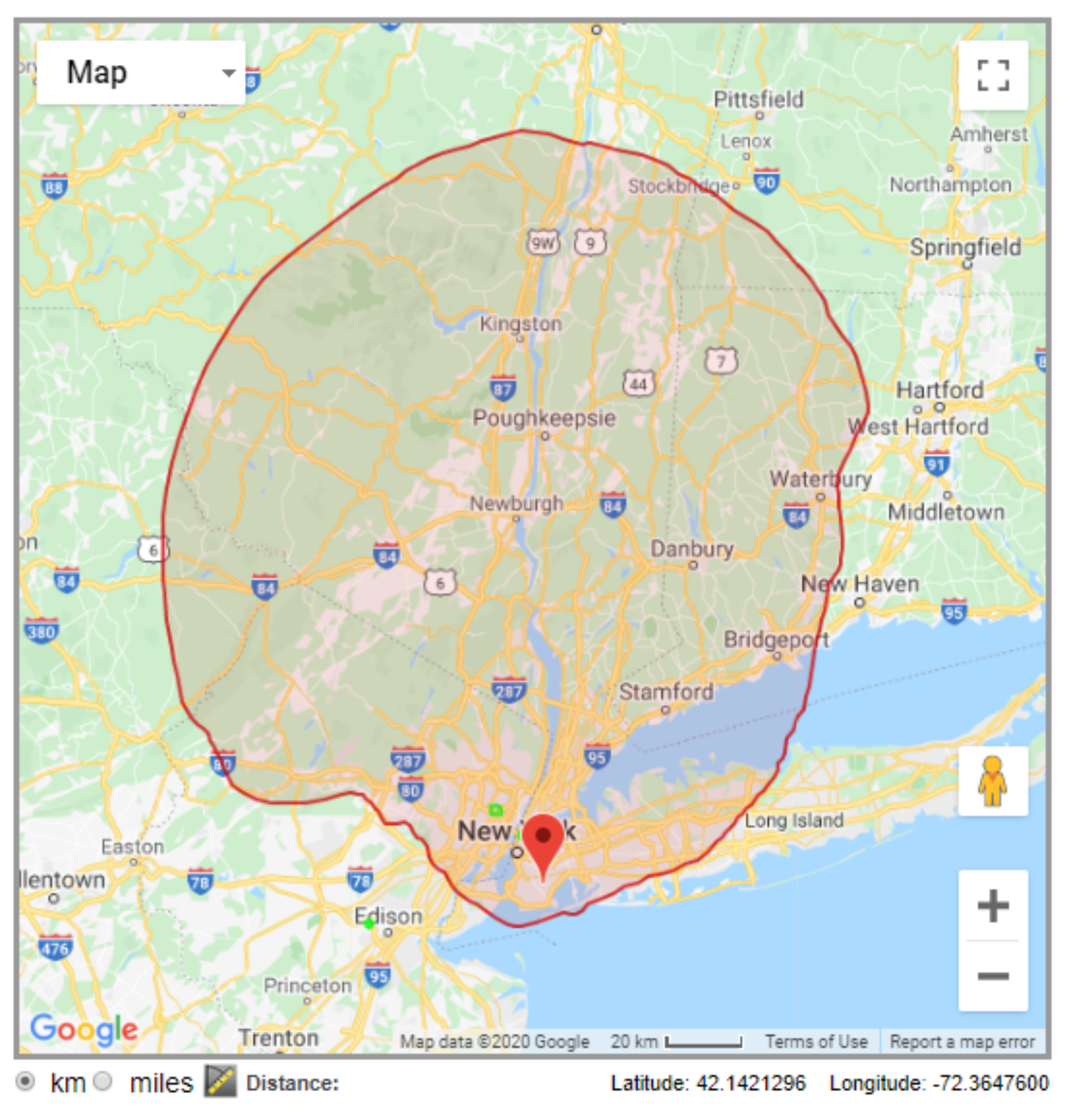
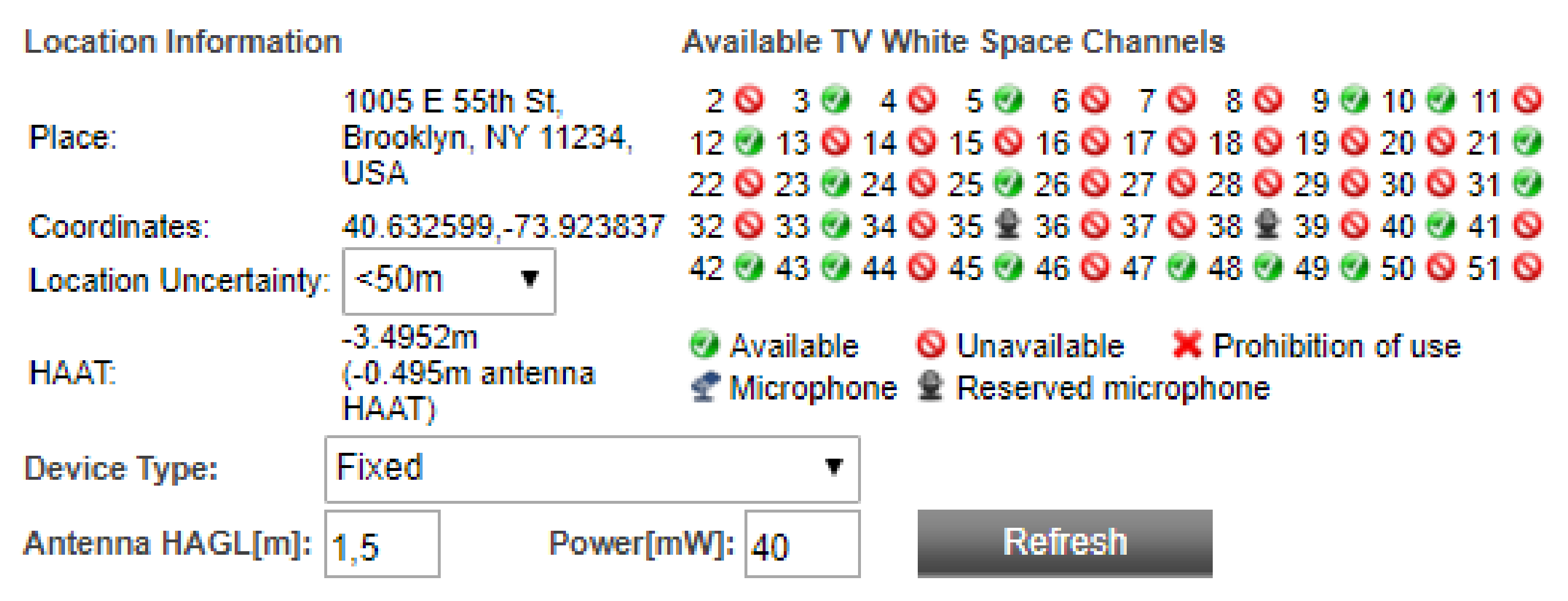
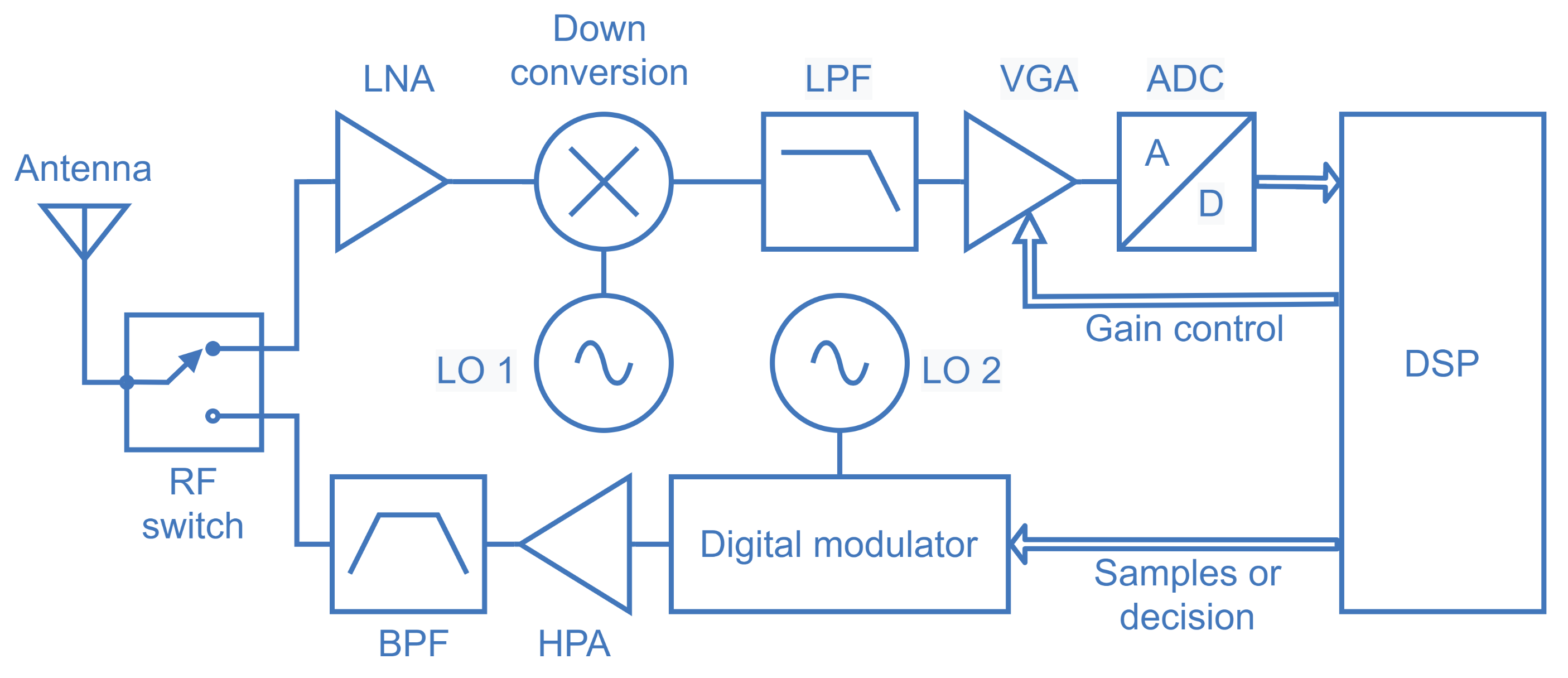
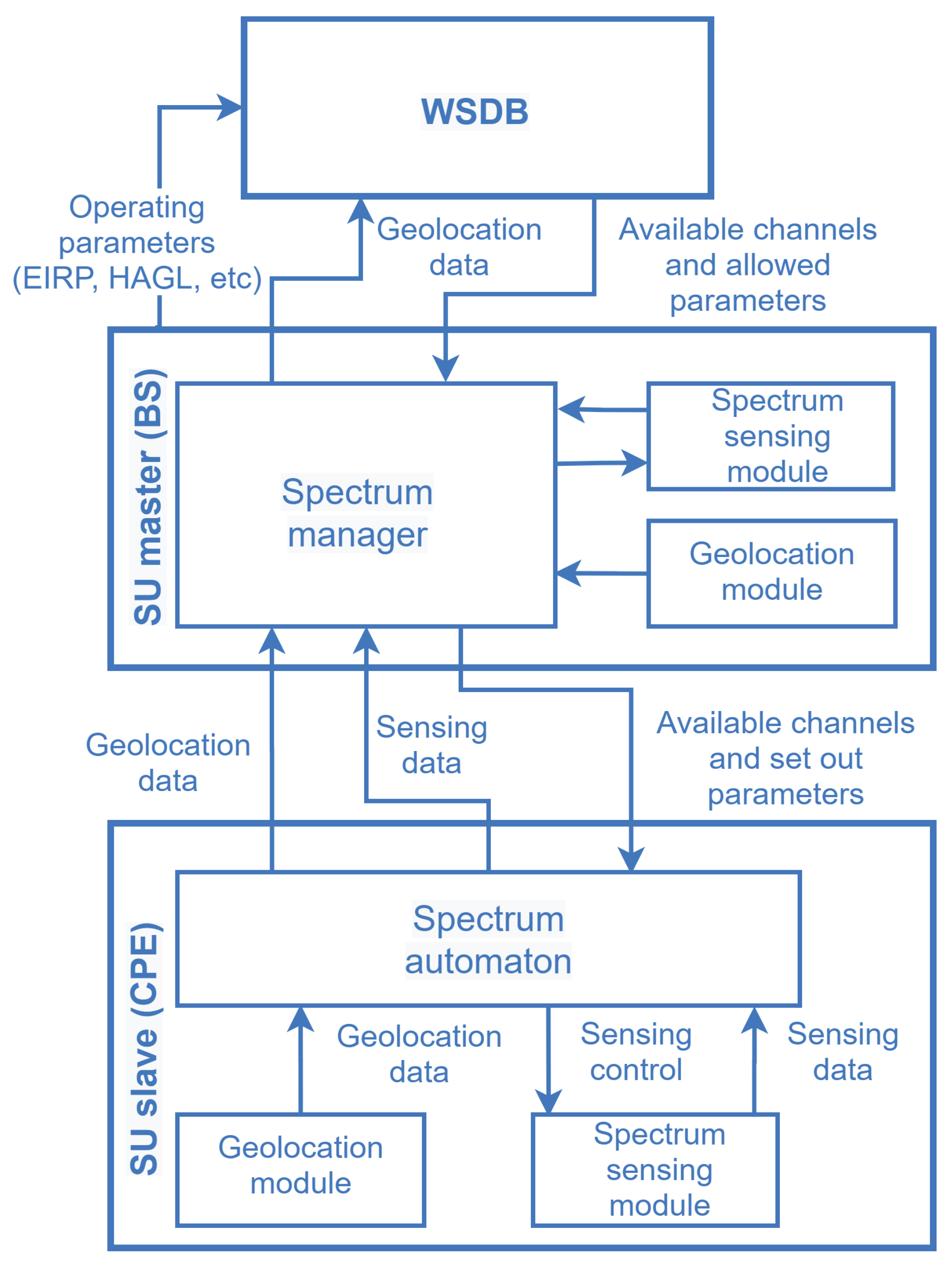
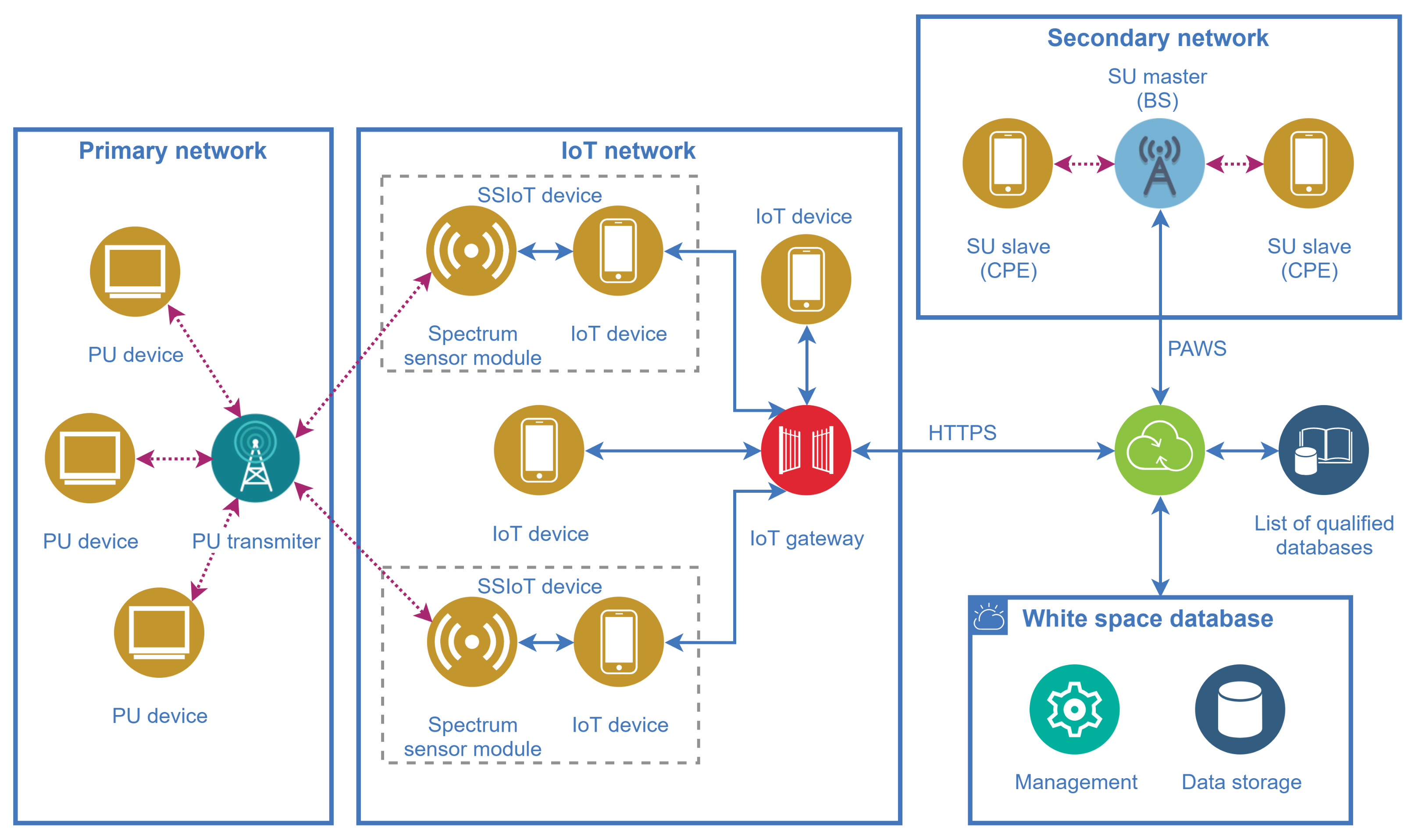
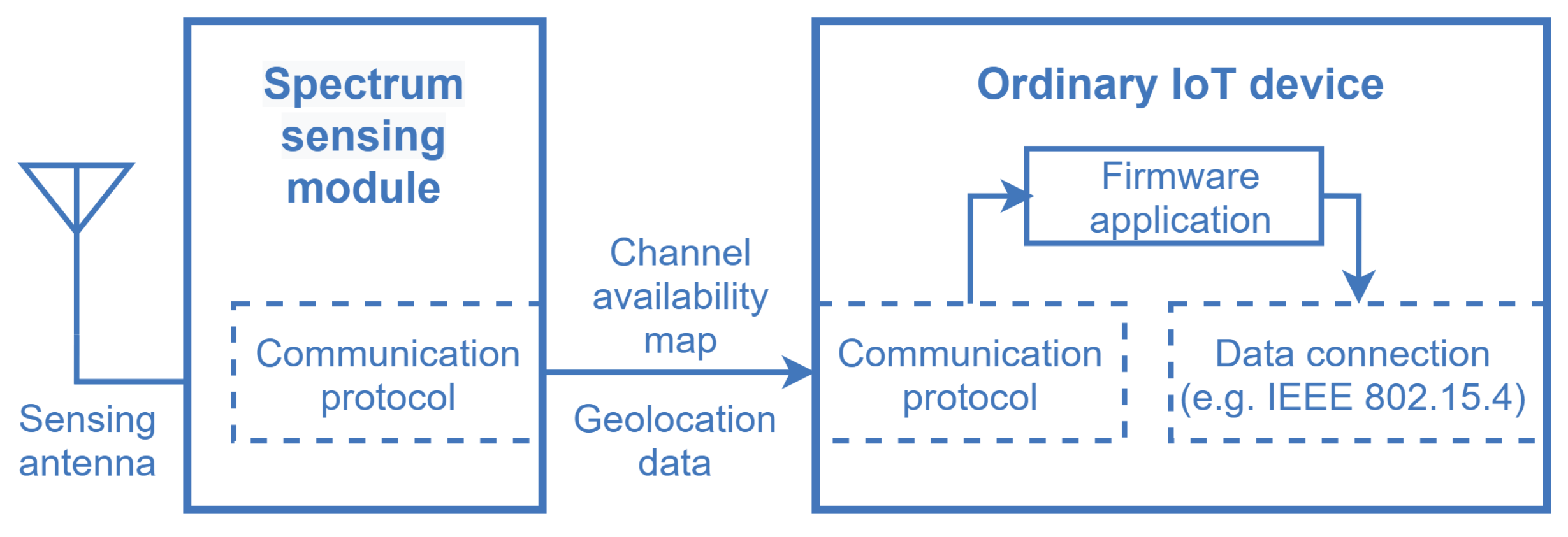
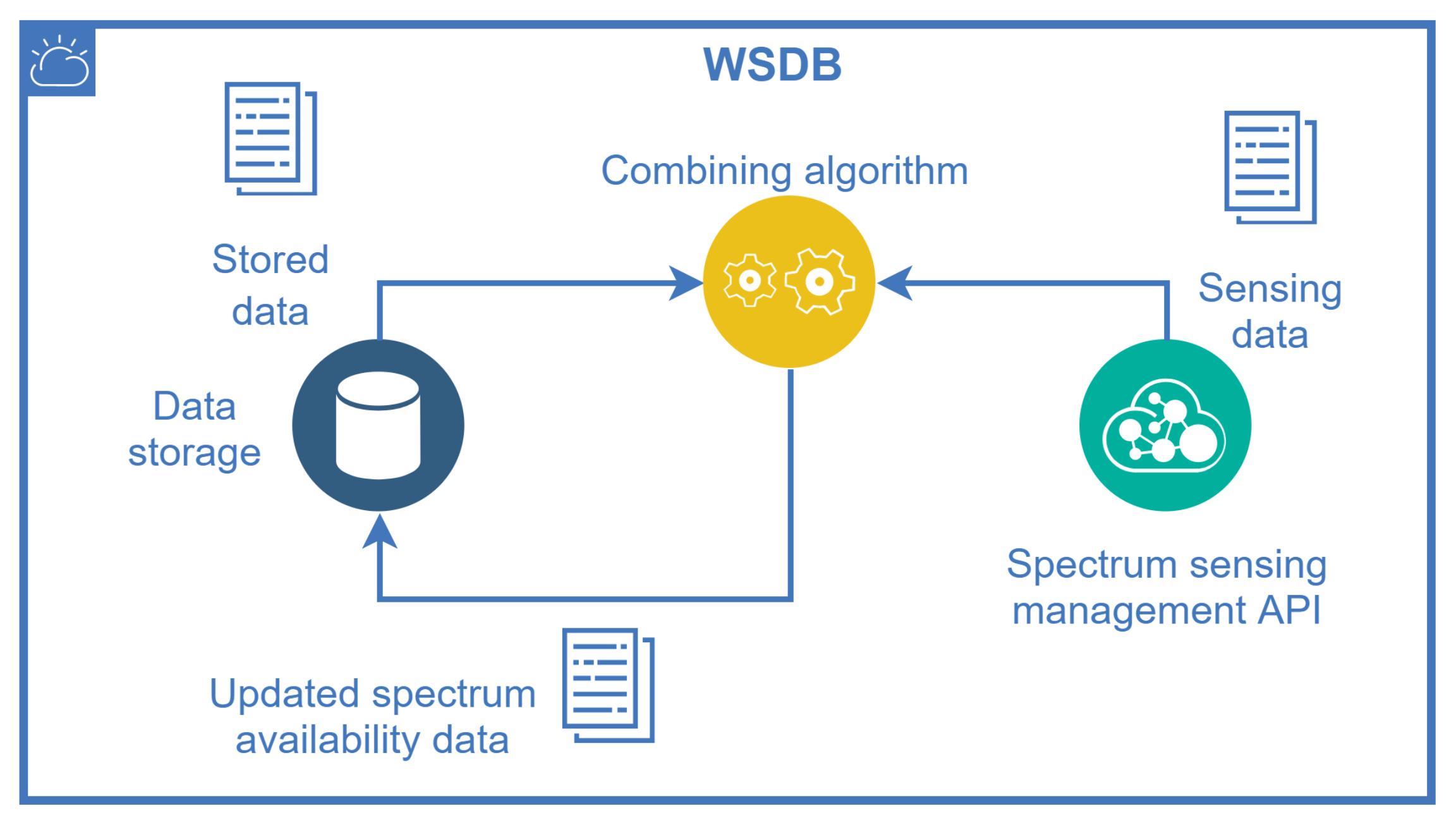
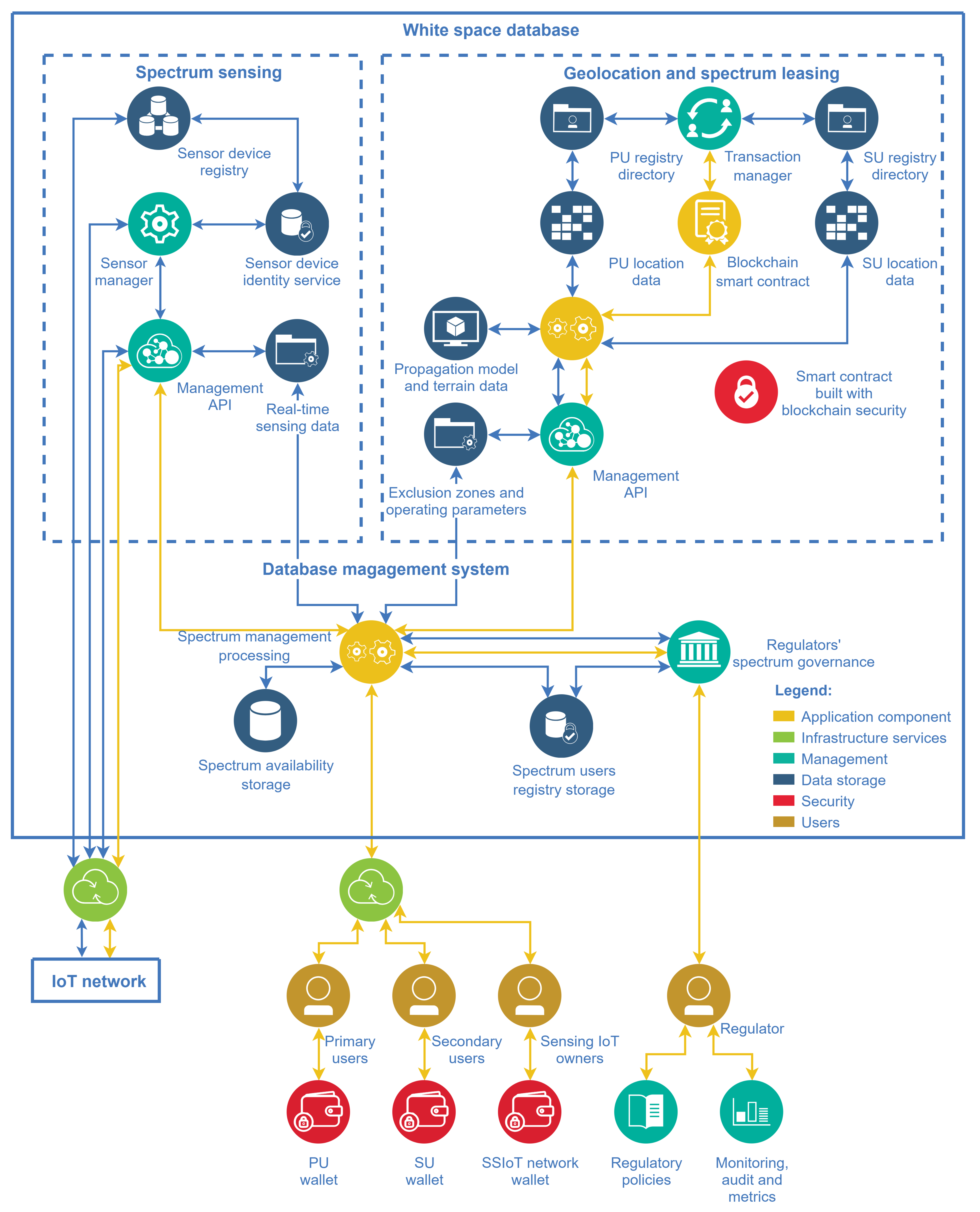
| Dimension | Description |
|---|---|
| D1 | Dynamic spectrum sharing and access policies. |
| D2 | Spectrum sensing. |
| D3 | Reliability, efficiency and consistency of spectrum information sharing and opportunistic decisions. |
| D4 | Realtimeness. |
| D5 | Low complexity and scalability. |
| D6 | Energy fingerprint. |
| D7 | Confidentiality, integrity, availability, authenticity, and immutability. |
| D8 | Spectrum sensing coverage. |
| D9 | Location awareness. |
| D10 | Cost-effectiveness. |
| D11 | Spectrum market as a service. |
| D12 | Artificial intelligence and machine learning. |
| D13 | Equipment, data, services and platforms interoperability. |
| Dimensions | |||||||||||||
|---|---|---|---|---|---|---|---|---|---|---|---|---|---|
| Related Work | D1 | D2 | D3 | D4 | D5 | D6 | D7 | D8 | D9 | D10 | D11 | D12 | D13 |
| Tang et al. [38] | ✓ | ✓ | ✓ | ✓ | |||||||||
| Aslam et al. [39] | ✓ | ✓ | ✓ | ✓ | ✓ | ||||||||
| FCC [27,28] | ✓ | ✓ | ✓ | ✓ | ✓ | ✓ | ✓ | ✓ | |||||
| Vartiainen et al. [40] | ✓ | ✓ | ✓ | ✓ | ✓ | ||||||||
| Paisana et al. [37] | ✓ | ✓ | ✓ | ✓ | ✓ | ||||||||
| Dionisio et al. [41] | ✓ | ✓ | ✓ | ✓ | ✓ | ✓ | ✓ | ✓ | |||||
| Tran et al. [43] | ✓ | ✓ | ✓ | ✓ | ✓ | ✓ | ✓ | ||||||
| Qin et al. [13] | ✓ | ✓ | ✓ | ✓ | ✓ | ✓ | |||||||
| Zhang et al. [44] | ✓ | ✓ | ✓ | ✓ | ✓ | ✓ | ✓ | ||||||
| Wang et al. [35] | ✓ | ✓ | ✓ | ✓ | ✓ | ||||||||
| Ma et al. [45] | ✓ | ✓ | ✓ | ✓ | ✓ | ✓ | ✓ | ||||||
| Ariyarathna et al. [14] | ✓ | ✓ | ✓ | ||||||||||
| Weiss et al. [46] | ✓ | ✓ | ✓ | ✓ | |||||||||
| Chen et al. [47] | ✓ | ✓ | ✓ | ||||||||||
| Hartog et al. [48] | ✓ | ✓ | |||||||||||
| Bayhan et al. [50] | ✓ | ✓ | ✓ | ✓ | ✓ | ✓ | ✓ | ✓ | |||||
| Maksymyuk et al. [51] | ✓ | ✓ | ✓ | ✓ | ✓ | ✓ | ✓ | ✓ | ✓ | ||||
| Liu et al. [52] | ✓ | ✓ | ✓ | ✓ | ✓ | ✓ | ✓ | ||||||
| Ali et al. [53] | ✓ | ✓ | ✓ | ✓ | ✓ | ||||||||
Short Biography of Authors
 | Dayan Adionel Guimarães received an MSc and a PhD in Electrical Engineering from the State University of Campinas (Unicamp), Brazil, in 1998 and 2003, respectively. He is a Researcher and Senior Lecturer in the National Institute of Telecommunications (Inatel), Brazil. His research interests are the general aspects of fixed and mobile wireless communications, specifically radio propagation, digital transmission, spectrum sensing for dynamic spectrum access, and convex optimization and signal processing applied to telecommunications. |
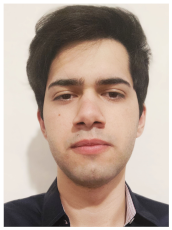 | Elivander J. T. Pereira received the degree of Bachelor of Engineering (2018) and the MSc on Telecommunications (2020) from the National Institute of Telecommunications (Inatel), Brazil. He is currently working towards his Doctorate on Telecommunications at Inatel. His research interests are mobile communications, digital transmission, cognitive radio, statistics and signal processing. |
 | Antonio Marcos Alberti is an associate professor and researcher at the National Institute of Telecommunications (Inatel), Brazil, since 2004. In 2012, Antonio was a visiting researcher at Future Internet Department of ETRI, in South Korea. He received the M.Sc. and Ph.D. degrees in Electrical Engineering from Campinas State University (Unicamp), Campinas, SP, Brazil, in 1998 and 2003, respectively. Since 2008, he is designing and implementing a future Internet architecture called NovaGenesis. He has authored or coauthored over 100 papers in refereed international journals and conferences. Since 2013 he has been acting as a Coordinator of Information and Communications Technologies (ICT) Laboratory at Inatel. |
 | Jonas Vilasbôas Moreira has specialization in SOA Cloud Computing and Connectivity, and in Network Engineering and Telecommunications Systems from the National Institute of Telecommunications (Inatel), Brazil, 2015 and 2018 respectively. He is as a System Specialist since 2012 at Inatel Competence Center (ICC), mostly involved in telecommunications projects. Since 2019 he is also a collaborator with the Information and Communications Technologies (ICT) Laboratory at Inatel. His research interests are the integration of computing and telecommunications techniques, specifically the use of blockchain as database for telecommunications. |
Publisher’s Note: MDPI stays neutral with regard to jurisdictional claims in published maps and institutional affiliations. |
© 2021 by the authors. Licensee MDPI, Basel, Switzerland. This article is an open access article distributed under the terms and conditions of the Creative Commons Attribution (CC BY) license (https://creativecommons.org/licenses/by/4.0/).
Share and Cite
Guimarães, D.A.; Pereira, E.J.T.; Alberti, A.M.; Moreira, J.V. Design Guidelines for Database-Driven Internet of Things-Enabled Dynamic Spectrum Access. Sensors 2021, 21, 3194. https://doi.org/10.3390/s21093194
Guimarães DA, Pereira EJT, Alberti AM, Moreira JV. Design Guidelines for Database-Driven Internet of Things-Enabled Dynamic Spectrum Access. Sensors. 2021; 21(9):3194. https://doi.org/10.3390/s21093194
Chicago/Turabian StyleGuimarães, Dayan A., Elivander J. T. Pereira, Antônio M. Alberti, and Jonas V. Moreira. 2021. "Design Guidelines for Database-Driven Internet of Things-Enabled Dynamic Spectrum Access" Sensors 21, no. 9: 3194. https://doi.org/10.3390/s21093194
APA StyleGuimarães, D. A., Pereira, E. J. T., Alberti, A. M., & Moreira, J. V. (2021). Design Guidelines for Database-Driven Internet of Things-Enabled Dynamic Spectrum Access. Sensors, 21(9), 3194. https://doi.org/10.3390/s21093194







